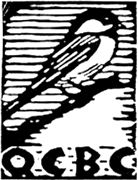- seeing and identifying wild birds
Here are some recommendations for beginners.
Basic equipment - binoculars and a Field Guide book.
- Binoculars. Without them, if you get close enough to a bird to see it well, the bird will fly away! Binoculars are specified with two numbers: the first number is the magnification, the second is the width of the wider lens. The second number should be at least 4 times the first to have a good field of view. Recommended size is 8x42 . 7x35 is also ok. Some birders use 10x42, but these are harder to hold steady. A lower-priced alternative to binoculars is a monocular (only one eye).
- Field Guide Book. Get one that has fewer species, not every bird in the world! A few popular ones are Sibley Birds East, Peterson Guide to Birds of Eastern and Central North America, and American Birding Association Field Guide to Birds of New York, written by QCBC member Corey Finger.
Apps and Websites.
- App “Merlin Bird ID” by the Cornell Lab of Ornithology. Free. It can help you identify a bird in one of three ways: 1. "Step by Step ID" - enter basic info about the bird, and it gives you a list of choices, with pictures of what the bird might be. 2. "Photo I.D." feature. This works well on a good photo. 3. "Sound I.D." This is the newest feature, and may not be accurate. It works best on longer songs, not short chip notes. It occasionally misses birds that are clearly vocalizing or identifies birds that are definitely NOT there. So, use Sound I.D. as a suggestion, not as definite evidence of a bird’s presence or absence
- Note that Merlin also has an “Explore” feature, like a field guide. You enter the species name, and it will provide a description, photos, and examples of sounds.
- Website www.allaboutbirds.org , also from the Cornell Lab of Ornithology. Gives more extensive information on each species than the Merlin app. Plus many interesting articles and educational resources.
- Website www.ebird.org and app eBird, also by Cornell Lab. Recommended for “Explore” to find out what birds are in your area - use “Explore Hotspots”. When you become more confident in bird identification, you may use the eBird app or website to enter your observations.
- Hint on eBird and Merlin apps: Download the apps when you have wi-fi, not in the field. Some of the i.d. options require additional downloads, so try out everything where you have wi-fi.
- www.aba.org is the website of the American Birding Association. Recommended reading: Code of Birding Ethics www.aba.org/aba-code-of-birding-ethics/
- See Queens County Bird Club website www.qcbirdclub.org , select Useful Links for other online resources.
Learning Bird Sounds. Once you start to identify birds by sight, you may also want to try to learn their sounds. Recommended CD: “Birding by Ear: Eastern/Central (Peterson Field Guides)” by Richard K. Walton and Robert W. Lawson. Sounds are also available on the Merlin app and www.allaboutbirds.org website.
Suggestions on cleaning and adjusting binoculars: Clean binoculars by spraying eyeglass liquid onto an eyeglass cloth and apply gently. Do NOT use Windex or paper towels.
Adjusting:
- Adjust the eyecups for distance to your eyes. If you wear glasses, make the eyepiece as close as possible.
- Push the barrels together or pull them apart to match the distance between your eyes. You should see a single circular image.
- Close your right eye. Use the center focus wheel to get an object in focus.
- Now, close your left eye and adjust the "diopter". It is usually on the right eyepiece, but it might be in the middle. You should have the adjust the diopter only one time.
- The binoculars should now be adjusted so you can see equally well with both eyes.
Make your yard a better habitat for birds.
- Hang a bird feeder for regular birdseed. Get one that is squirrel resistant.
- Hang a suet cage with a suet cake. This is neater than seeds.
- Install a bird bath. Inexpensive alternative: a ceramic plant dish on a small stand or table. Put a rock in the birdbath so the birds can see how deep the water is.
- Provide some place for birds to hide in, like a or brush pile or live shrub.
- Plant native plants that attract birds. The benefits of native plants are that they provide fruits and seeds that native birds can eat, and our insects are adapted to using them. You may think of insects and spiders as pests, but birds use them as food. See www.audubon.org/plantsforbirds for suggestions on which native plants to choose.
